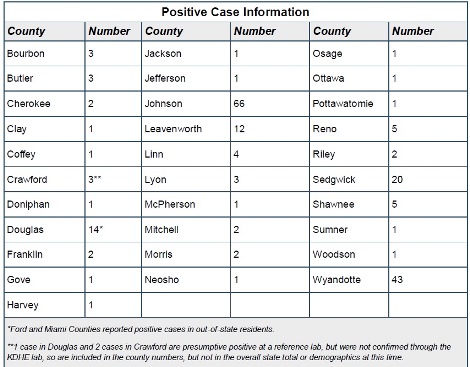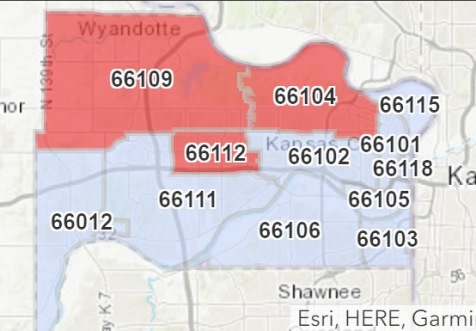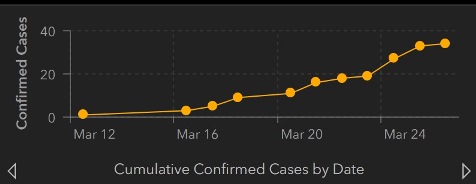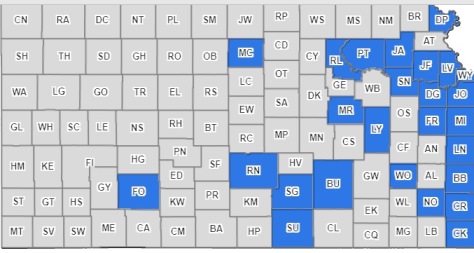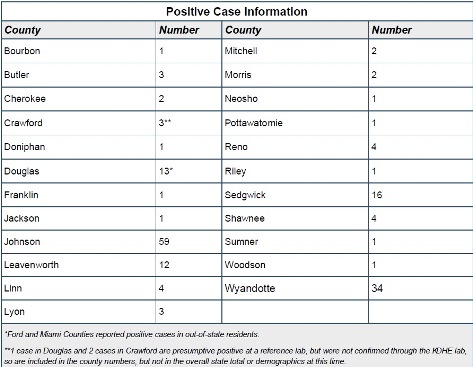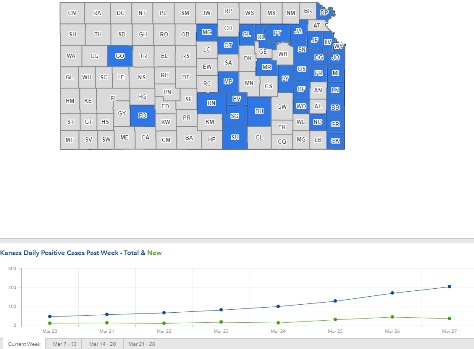
Wyandotte County cases increase to 43
COVID-19 cases in Kansas have increased to 202 on Friday morning, according to the Kansas Department of Health and Environment.
Dr. Lee Norman, KDHE secretary, said in a news conference on Friday that Kansas is beginning to see COVID-19 spread to more counties throughout the state.
Wyandotte County was reported at 43 cases Friday morning, compared to 34 cases reported Thursday morning, an increase of 13 cases. The total increased to 46 by Friday evening, according to the UG’s website.
The third COVID-19 related death in Wyandotte County was reported Thursday evening.
Johnson County reported 66 cases on Friday morning, as compared to 59 cases on Thursday morning, according to KDHE statistics.
Sedgwick County, including the Wichita area, reported 20 cases Friday morning, while Douglas County, including the Lawrence area, reported 14 cases. Leavenworth County reported 12 cases. Shawnee County had 5 cases.
As expected, the population centers, Johnson, Wyandotte, Douglas and Sedgwick counties, have had the most cases at this point, Dr. Norman said. But it is spreading out now, even into western Kansas, he added.
He said he was hopeful that the peak would be reached by mid-April, perhaps by April 24.
He said residents need to stay home and maintain social distancing. If they do that, then perhaps the coronavirus will peak in mid-April.
“Vigilance needs to remain high,” he said.
He said he saw some residents washing their cars at a car wash in Shawnee County, and that was not a necessary function.
“This is not about gaming the system and playing with the words to skate around the exemptions,” he said. “It’s about staying home and staying out of harm’s way.”
Currently Kansas is not doubling every three ofr four days, which is encouraging, according to Dr. Norman. He would not be surprised if the state had 900 to 1,000 patients eventually. It would be a higher number if the residents do not follow the guidance of staying home and social distancing.
He said some have indicated the changing of the seasons and warmer weather also could contribute to a fall in the disease rate, however, it could be back in the fall.
The state’s lab is getting more equipment this weekend to allow to to test more, he said. Friday’s results showed 135 private lab positive tests and 67 state lab positive tests.
The state lab now is able to handle about 175 specimens a day, he said.
There are efforts underway for more testing in different locations, he said.
KDHE also receive two semis full of protective equipment from the national stockpile and will be able to fill requests from 25 counties for more equipment, he added. The state will soon tap out its entire allotment, and will be looking for ways to get more supplies in the future, including possibly companies that would manufacture it.
At another news teleconference on Friday, doctors at the University of Kansas Health System emphasized the importance of staying home, and they also talked about increasing telehealth visits with patients.
Dr. Steve Stites, chief medical officer at KU Health System, said that Chinese medical professionals have reported that those health care workers who used proper personal protective equipment did not catch COVID-19. He said that was important to know as local health officials now believe they are on the ascending side of the curve in the Kansas City area.
If the Kansas City area has a 5 to 20 percent surge in cases, then they will be well prepared, he said.
“New York got stretched because they had so many people hit so fast,” he said.
The difference in activity rate accounts for some of the larger numbers of New York cases, Dr. Stites believes.
“It’s all about staying at home,” Dr. Stites said. “If people will stay at home,” he said. “then you will flatten the curve and have enough personal protective equipment. If we don’t, we’re all going to suffer the consequences of that.”
Dr. Dana Hawkinson, medical director of infection prevention and control at KU Health System, said there are 18 positive COVID-19 patients currently at the hospital, including 10 in the intensive care unit, and six are incubated.
He said they are stressing training and good hand hygiene. Proper hand hygiene and keeping hands away from the face continue to be effective ways to stop the spread of the disease.
Dr. Keith Sale, vice president of ambulatory services at KU Health System, said the health system is ramping up telemedicine to serve outpatients. They will be able to stay at home and stay safe while still receiving medical advice through video conferences or through other means such as the telephone.
To view the KDHE news conference, with more detailed information, visit https://www.facebook.com/KDHEnews/videos/2275555782749312/?__tn__=%2Cd%2CP-R&eid=ARAexWkbKtwNSgaPu6y0kGFJfA_6ZdhYQPNMKazXT1zvdTDfeNkEAgsUTN11dggTyP202Pq-p_Q969Mi.
To view the KU Health System news conference video, with more detailed information, visit https://www.youtube.com/watch?v=gqippHdA0zA&feature=youtu.be.
The Kansas COVID-19 website is at
https://govstatus.egov.com/coronavirus.
The UG’s COVID-19 response website is at
https://alpha.wycokck.org/Coronavirus-COVID-19-Information.
COVID-19 information from the CDC is at https://www.cdc.gov/coronavirus/2019-nCoV/index.html.
